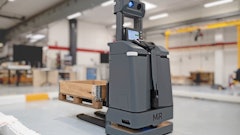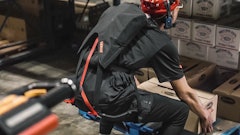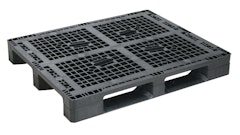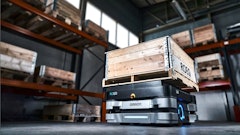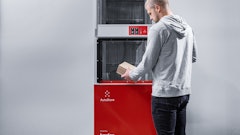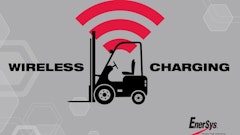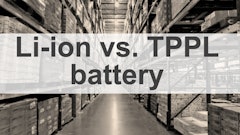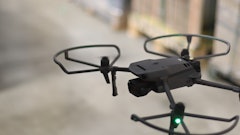The food industry is among the most competitive out there. Low margins force companies to continually look for ways to increase productivity and improve cost-effectiveness, all while delivering top-notch customer service.
One of the ways that food retailers, distributors and manufacturers are accomplishing this is with the use of automated storage and retrieval systems (AS/RS) in their distribution centers. But while AS/RS can provide many benefits for food distribution, it also comes with a hefty price tag-$1 million at a bare minimum and on up to tens of millions for more sophisticated configurations.
With that kind of an investment, you need to make sure that AS/RS is a good fit for your operation before even beginning to put together a request for proposals. Most AS/RS vendors recommend that to understand whether or not AS/RS is right for your operations, you first consider a long list of criteria.
The Benefits
If AS/RS is the right fit for your operation, the benefits are several, according to Ken Ruehrdanz of Siemens Logistics and Assembly Systems, Grand Rapids. MI. He names the following:
- Reduction in bio-mechanical injuries: Food distribution centers primarily handle case goods that tend to be heavy, especially when a worker handles the case loads for an entire shift. Workers will bend, lift and twist hundreds of times each day while handling cases of food. Injuries can be devastating to the health of workers, not to mention medical and absentee costs. AS/RS can accommodate cases and pallets automatically, allowing fewer "touches" by human hands.
- Reduce exposure to harsh working environments: Freezer storage often requires that product be held in sub-zero temperatures, which is not ideal for worker comfort and health. Turnover is high in these jobs. An AS/RS can automate the warehouse storage function and allow staff to work outside in the freezer or cooler environment.
- Reduction in building and energy costs: Freezer and cooler space is costly to build and maintain; AS/RS can minimize freezer/cooler space. The implementation of an AS/RS allows high-density storage and will therefore reduce the footprint and square footage of the freezer or cooler, thus reducing building and energy costs.
- Improved inventory control and accuracy: For food producers, it is extremely important to make sure first in/first out strategies are maintained. When compared to traditional methods, AS/RS operates under computer control so product does not get misplaced in the warehouse, ensuring FIFO.
- Reduced truck fleet and labor: AS/RS requires less staff to perform work. When AS/RS is used in two- or three-shift operations, significant re-turn on investment can be realized. Furthermore, AS/RS means a reduction in facility damage by manually operated forklifts and in product damage.
Mike Kotecki, senior vice president at HK Systems in Milwaukee, adds that AS/RS can provide increased functionality to operations. Inventory accuracy will improve, he says, because AS/RS provides 100 percent computer controlled material movement. It eliminates physical inventories, thereby providing for 100 percent inventory accuracy.
Another functionality improvement, according to Kotecki, is inventory optimization. "A and B items are stored closer to the point of use, leading to automated velocity zoning based on turn rate," he explains. He adds that you also can achieve just-in-time delivery of sequenced product to shipping or production by creating and allocating virtual batches for future use.
It's because of these benefits that AS/RS has found a home in the food industry. Retailers, manufacturers and distributors alike can all reap the benefits of the technology, says Ken Matson, executive vice president at FKI Logistex in St. Louis. "It's more a question of facility than it is industry," he says. "AS/RS can fit into a number of applications and may apply across a number of facilities."
Currently, retail is one of the biggest AS/RS users. "For retailers, there's a lot of pressure to deliver more often and in smaller quantities," says Bill Ostermeyer, vice president of automated solutions at Swisslog in Newport News, VA. "One of the drivers needed to justify AS/RS is a high number of orders and lines."
With the substantial benefits of AS/RS, even with its high cost, choosing that equipment for a warehouse is tempting. But before making that decision, you have to consider several factors.
Chief among the issues you must address in making a decision about bringing on AS/RS is whether or not your facility includes a freezer environment. "AS/RS is a fit in both cold and dry applications, but it's easier to justify in a cold environment," says Swisslog's Ostermeyer. "You can decrease your footprint with AS/RS, which will bring energy costs down. You can also get your people out of the freezer."
Siemen's Ruehrdanz agrees. "AS/RS is well suited for both cold and dry storage," he says. "However, cold storage has a stronger ROI as energy cost savings are more significant for freezer/cooler applications. AS/RS allows high-density storage and therefore, a smaller cube to refrigerate."
Another issue to consider is your facility's size and throughput. "AS/RS applications are driven more by throughput rates and storage capacity required, which in turn translates into a facility size," says Ruehrdanz. "Throughput rates around 20 loads per hour and storage capacity of 5,000 pallets is considered a minimum requirement for ROI."
Ostermeyer says that when it comes to facility size, there's no real rule of thumb for AS/RS. However, the technology can be a great fit for companies running out of space. "Good candidates are those DCs where space is tight and making a move to another DC would be very costly," he says "You can usually expect to reduce your square footage by about a third to half with the addition of AS/RS."
Steve Plothow, senior logistics engineer at Daifuku America, based in Salt Lake City, says that a typical AS/RS candidate might have between 5,000 and 25,000 pallet locations. In addition, he says, DCs with high ceiling height can make the most of the technology, which can go as high as 120 feet.
FKI's Matson says that ceiling height is an important factor to consider. "If you're in an old DC where the ceiling height is too low, you can't really get the most out of AS/RS," he says.
Know Your SKUs
SKU count is another part of the equation. "AS/RS can handle as few as 500 SKUs," says Plothow. "But we have many more applications where you have between 5,000 and 6,000 SKUs."
Brian Sherman, manager of business development at Witron, based in Arlington Heights, IL, says that "we like to see a lot of movement to show an ROI, especially if the SKU count is on the lower end of the spectrum."
The bottom line when it comes to size, says HK System's Kotecki, is "does the ROI make sense?" He adds, "If the technology and unit of storage makes sense, the rationale is scalable. Historically we've tended to put larger systems into larger buildings. But we've also done very small projects and have one customer that has deployed AS/RS in just one aisle."
The cost of AS/RS-always a factor-is all over the board, but as mentioned earlier, is expensive. On a per-aisle basis, you can expect to spend from $250,000 to $1.2 million, says Siemen's Ruehrdanz.
Plothow says that an average 25,000 pallet system right now might cost around $13 million. "One thing that can affect the price," he adds, "is what equipment you already have in place and what infrastructure you might need to add to support AS/RS."
Typically, says Plothow, U.S. companies are looking for an ROI in about three years, while in Europe it tends to run about five to seven years due to a different profile. Cost justification will come through several factors, he says, including improved accuracy, reduced labor costs, improved security, and better space utilization. "Even with all that," he says, "you still have to have the velocity and the right type of items to justify it."
When AS/RS Isn't For You
In spite of the gains that can be achieved from AS/RS, there are certain scenarios when it is not appropriate. One, says FKI's Matson, is in operations where pallets aren't of a standard size and quality. "If you don't have good pallet quality, it can be a big challenge," he says. "Also you want to make sure that the load is of good quality, otherwise it will cause problems with an AS/RS."
Distribution centers with low throughput operations are also poor candidates for AS/RS, says Ruehrdanz, as are those with an extreme variety in order fulfillment and storage.
If you have a peak season, AS/RS is likely not a good fit either, says Ostermeyer. "If you have a time of the year where you need to move things three times faster than normal, AS/RS probably won't work," he says.
Another inappropriate fit is when labor is plentiful and land is cheap-this leaves you without much justification. Also, if your company is in "survival" mode, you don't want to invest in AS/RS. "It's not the right time to make a long-term investment in a big asset," says Kotecki.
Avoiding Mistakes
If the justification is there for an AS/RS, you still have to be careful to avoid some of the common pitfalls associated with it. For instance, says Ruehrdanz, sometimes "users don't understand their throughput requirements and may undersize or oversize their system."
Another mistake many AS/RS users make is not preparing culturally for the automation, says Kotecki. "You have to understand that there are responsibilities that come with the automation, such as maintenance," he points out. "But with proper coaching from your integrator and understanding from senior management, it can work out."
Ostermeyer warns of suppliers that might try to "force feed" all of a distibution center's SKUs into an AS/RS. "Do your due diligence and look at all your SKUs to know which ones are a fit," he says. "If you put them all into an AS/RS, you limit your flexibility."
Matson says that it's important also to keep clearance in mind. "Too often, the customer may have a system designed on the wrong clearance height and then find out that it won't fit," he says. "AS/RS needs more clearance than most people realize."
Finally, Witron's Sherman recommends watching how much technology you purchase. "There are some suppliers who will try to push too much of everything-too many cranes, too many conveyors and other ancillary equipment," he says.
The bottom line is that when done right and in the right application, AS/RS can do wonders for your operations. "AS/RS can be appropriate as a tool to increase your efficiency and reduce costs," says Kotecki. "It can also serve as an investment to improve customer service."
European 3PL Makes The Most Of AS/RS
One of the big advantages of AS/RS is its ability to handle rapid throughput of hundreds of SKUs. It was this fact that made the technology a good fit for Kloosterboer, a third-party logistics provider in the Netherlands.
Kloosterboer began originally as a wholesale vegetable business. Today, however, the company emphasizes warehousing, shipping, boat loading and customs for temperature-controlled items such as meat, dairy and potato products. The company also handles goods such as sugar, nuts and industrial products.
The company handles logistics for 350 customers from 30 different countries. It operates eight facilities throughout the Netherlands, Norway and the Faeroe Islands.
When potato products company Farm Frites selected Kloosterboer as its 3PL, the company was faced with new challenges. Kloosterboer needed to find a facility that was capable of storing 60,000 pallet positions, could handle throughput rates of up to 360 pallets an hour, and provide 100 percent traceability of all their products.
In order to provide these services cost-effectively, Kloosterboer needed to provide an automated warehouse for Farm Frites. One of the challenges Kloosterboer faced was the high cost of land in Europe. In addition, the company wanted a solution that would reduce the labor required to provide the high throughput required by the customer.
The company turned to York, PA-based Westfalia Technologies, a provider of automated storage solutions, to develop a concept that would fulfill Farm Frites' needs. Westfalia's satellite technology fit the bill and was installed in the Kloosterboer DC in 2003.
The satellite system is a unique AS/RS that can store and retrieve pallets up to 12 deep on either side of the crane aisle. This provided the high-density storage necessary to accommodate the Farm Frites account.
"This allowed Kloosterboer to build a DC capable of storing 60,000 pallet positions on a footprint of 113,000 square feet," explains Allison Kapalka, marketing manager at Westfalia Technologies.
In addition, the satellite system can move two pallets at the same time. That feature made it possible for Kloosterboer to meet the throughput rates of 360 pallets an hour with only four cranes in all.
The DC is laid out so that four storage and retrieval machines travel at speeds of 656 feet per minute horizontally and the satellite stores and retrieves pallets up to 12 deep at a speed of 295 feet per minute. Pallets are then transported from storage to shipping via chain conveyors, transfer cars and turntables.
After the products reach the shipping and receiving area, they are met by a Westfalia SpeedLoader, which loads and unloads pallets and cargo automatically. Orders are arranged in the correct sequence on stationary conveyor belts prior to the arrival of trucks. The trailers, also equipped with integrated conveyor belts, dock at the loading station directly in line with the conveyor belts in the shipping area. The SpeedLoader covers a distance of 150,000 miles each year. About 3,000 pallets a day of Farm Frites products leave the Kloosterboer DC each day.
Since adding the new Westfalia systems, Kloosterboer has been able to reduce personnel costs and cut the time required to complete operations.













